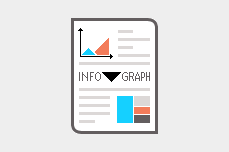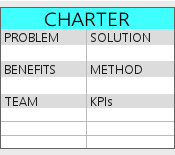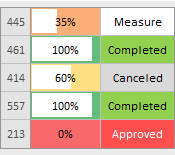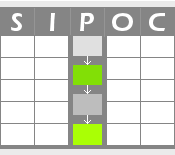
Also known as Project Summary, Project Initiation Document, and Project Definition Report.
Variants include Project Statement of Work and Terms of Reference.
Once a project opportunity has been identified, it must be translated from a conceptual idea into a well-written project charter. A project charter is a concise, one-page document that summarizes the fundamental information of the project before it begins. This vital document clarifies project objectives and scope, addresses the needs of stakeholders, and defines roles and responsibilities of the project team. The completion and endorsement of the project charter are prerequisites for the project kick-off.
The components of a project charter vary depending on the methodology used. For example, it is used in the Define phase of Lean Six Sigma to include elements that are related to the process improvement methodology, such as a summary of the voice of the customer (VOC), defect definition, baseline defect levels, and COPQ. It is important to note that although project charters are short and brief, they often refer to more detailed documents.
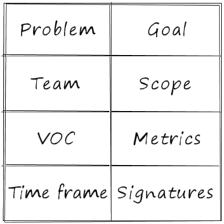
Let’s discuss now the key elements of a typical project charter.
Business Case Summary
A comprehensive business case analysis must precede the initiation of any project to provide a justification for the project’s selection. A business case summary should be integrated into the project charter to outline the impact on the business in terms of benefits or cost savings.
Problem Statement
A problem exists when there is a difference between the current state and the desired state. A problem statement should be specific and brief and should describe when and how often the problem occurs. It should not however include background information, nor should it discuss the causes or solutions.
Goal Statement
A goal statement defines the target for the project and should respond to the problem statement. It should be brief, specific, clearly define the purpose of the project, should not be using technical language, and should not assume or suggest solutions.
For example, the following is a goal statement which has been created for a project in a manufacturing facility: “Reduce oil losses of the manual refilling process of the forming machines in line #4 to less than 1% per drum by the 30th of October”.

Project Team
A project team is typically composed of a dedicated project leader and team members directed by a project sponsor. The project leader is responsible for providing direction, communication, facilitation, monitoring, and tracking. Team members are responsible for executing the project activities to produce the desired outcomes. The project sponsor facilitates the provision of necessary resources and provides support as required for the project’s successful execution.
Project Scope
The project scope defines what is involved in the project and what is not. It is important to identify the products, services, processes, departments, locations, and customers during the project’s definition phase. It is also important to avoid the temptation of expanding the scope of the project, as it may lead to not being able to complete the project within the allocated time. Additionally, more resources will be required.

Voice of the Customer
Customers are the elements that identify the need for executing the project. It is important to take their voice into consideration during the project definition phase. In some instances, a customer representative may be required to evaluate the outcomes of the project definition process and provide feedback as required.
Project Metrics
The utilization of project metrics brings attention to the future progress and results. It keeps the project team focused to achieve the project goals and expectations. The success of any project is often measured by a primary metric, a financial metric, or a combination of both. Tracking these metrics is important not only during the project period but also several years following its completion.

Project Time Frame
A project’s time frame is the time required to complete the project, and typically represented by its start and expected completion dates. It is possible to assign an approximate completion date, however, this should be revised as the project progresses.
Project Authorization Section
The signatures of key stakeholders on the project charter indicate formal approval of the project and empowers the project leader to proceed. Additionally, obtaining the signature of a financial representative provides credibility and support to the proposed financial gains.
There are many other elements that can be added to the project charter depending on the specific project management methodology being employed, including:
- A list of key stakeholders affecting or being affected by the project.
- Project approach or implementation methodology.
- Key milestones which could be simply the completion of each project stage.
- Key deliverables at every stage.
- A communication plan summary.
- The required resources needed for the project.
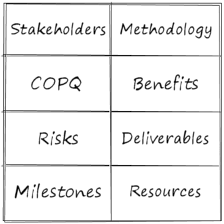
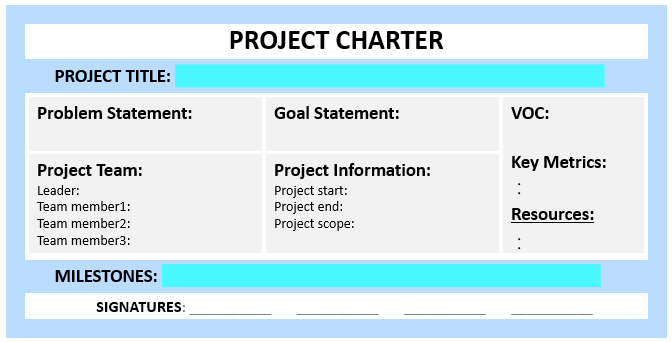
Preparing an Effective Project Charter
The following guidelines will assist in creating an effective Project Charter.
- A project charter should be customer focused and addresses their specific needs.
- It should be clear and concise (preferably one page).
- It should contain realistic and achievable objectives (use the SMART checklist).
- It should be developed as a collaborative effort.
- It should be dealt with as a live document during the project lifetime.
- It should be updated as the project progresses.

There are many tools that can help in the creation of a project charter. One of the simplest and most straightforward ways is to use this project charter template.
Wrapping Up
A project charter is a one-page document that enables stakeholders to review the project and commit to support. It stands as an essential preliminary step across various project management methodologies. In the context of Lean Six Sigma, for example, it is used to summarize the findings of the Define phase. Meanwhile and as per the PMBOK, it is a document that formally authorizes the existence of the project. The information within the project charter is critical for obtaining leadership support and commitment. Once signed, it authorizes the project leader to formally initiate the project and access the necessary resources, including financial resources.
Other Formats
Do you want to use the slides in your training courses?

Project Charter Training Material – $18.85
Related Articles
Related Templates


